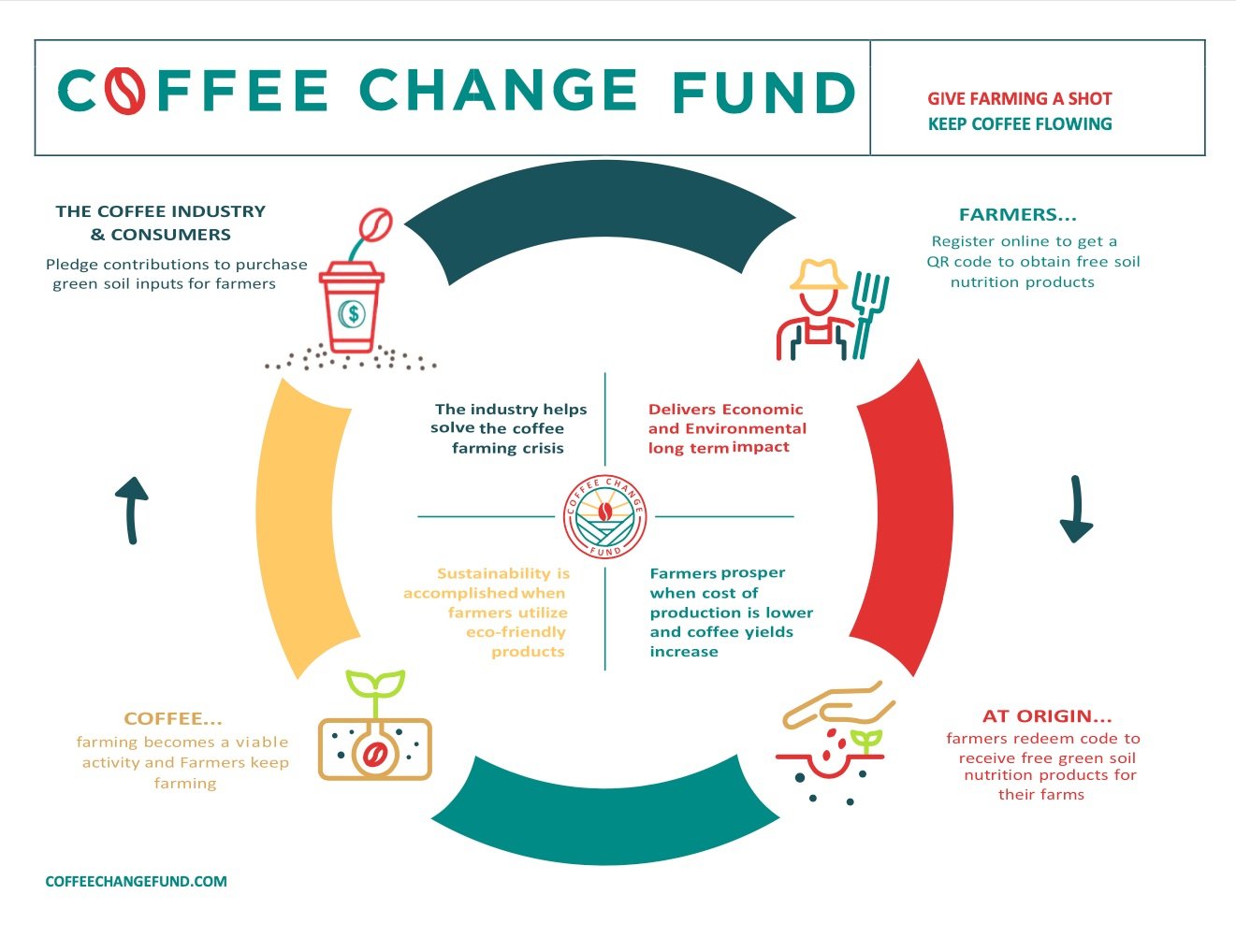Can the Coffee Change Fund Save Coffee?
A coffee producer with a simple and affordable redistribution plan struggles to find industry backing.

Coffee production is in crisis. Across the globe farmers struggle to make ends meet through growing coffee, and as the climate crisis intensifies it’s only going to get worse. An industry that generates hundreds of billions of dollars every year is built on the backs of smallholder farmers who do most of the work and receive little of the revenue.
If coffee is to survive into the next century (and it’s not a guarantee that it will, at least not in the form we know today) then something will have to give. Farmers are giving up and selling their land, or switching to less fragile and more lucrative crops. Paying more for coffee is one approach to redistribute some of the wealth, although while seemingly simple it might not be the silver bullet many think (for more on that I recommend this episode of Boss Barista with Semilla Coffee’s Brendan Adams).
Marianella Baez Jost, a coffee farmer in Costa Rica, has another solution: it’s relatively simple, very affordable, and could have a big impact. The trouble is, she can’t do it alone and so far, the industry has not been willing to listen.
Although Baez Jost is Costa Rican she had been living in the United States for many years when together with her husband she decided to buy a coffee farm back home. She calls herself “a producer by choice, not destiny”, and using connections back in the States she has been able to sell coffee directly to roasters as well as help other Costa Rican farmers do the same through Farmers Project.
“I have lived through starting a farm and trying to establish a market that will pay you at least enough to survive and realizing that there isn’t one at origin,” Baez Jost tells me. “Direct trade was the only exit, and we had to come back to the United States to establish relationships so that it’s sustainable. Now I’ve given myself the biggest mission, which is how do we solve this coffee pricing problem?”
The problem, as Baez Jost sees it, is that the coffee industry is fundamentally broken. “We can’t fix the supply chain, we can’t fix the C market,” she says. “Coffee is a commodity, and the C market is always going to pull us down because it’s supply and demand. It’s a race to the bottom.”
Instead of trying to fix the entire supply chain, Baez Jost wants to do something relatively simple utilizing existing technology: use contributions from the consuming end of the chain to buy inputs for those working at the producing end. All transparent, all traceable, with no “hands in the pie” as she puts it. This is the Coffee Change Fund.
The pitch is simple: roasters, cafes, importers pledge a monthly or annual sum, collected and managed by a centralized fund and used to purchase already-locally-available inputs in producing countries. “The technology exists,” Baez Jost explains. “The reason this solution works is because it’s an innovative delivery of help—the way the help gets to the farmer is what differentiates this idea from all the existing ones. And it’s 100% traceable and uses real time metrics.”
Farmers sign up for the program and fill out a short survey, which is used to match their needs with specific inputs. They then pick up the supplies at their local stores, using a personalized QR code that returns data to the fund which oversees the entire cycle for reporting. Baez Jost emphasizes that these will be environmentally friendly inputs, because another of her goals is soil regeneration. “We help the farmer restore the soil, because right now everybody is applying either nothing or really bad shit to the soil,” she says.
The most important aspect of the Coffee Change Fund is that Baez Jost estimates it will save farmers a huge chunk of the cost of production. “We're helping all these farmers produce with 35% less cost so they don't have to choose between feeding their family or feeding the ground that they're trying to grow coffee in,” she says. Cost of fertilizer and other inputs has skyrocketed over the last few years, especially in the wake of Russia’s invasion of Ukraine. This has made coffee production, already a difficult industry in which to make a living, even more precarious.
The money pledged by consumer-end individuals and companies will flow through a fund managed by an NGO or similar organization and onwards to handpicked agro-supply companies with established networks in the producing countries. Then the data flows back in the form of real time reports for those who donated to show their customers or shareholders.
“It’s so important that we have that data to show people the impact,” Baez Jost tells me. “We want to make sure that the metrics flow back in a very visual way, for the world to see that we are solving this problem. That’s the only thing that’s going to make this systemic, because people are not going to keep on giving money if they don't see where it goes.”

Her plan works, Baez Jost says, because the technology and the ways to implement it already exist in different forms. The Coffee Change Fund takes the pieces and fits them together. The issue isn’t practical, as she sees it—it’s political. She has spoken to a few powerful people at big coffee companies, each of whom told her the Coffee Change Fund was a good idea but that they couldn’t help her.
One coffee CEO told her that he would need pre-competitive support, where usually-competing companies come together to solve a problem in their sector. “And that’s very hard to get in our industry,” Baez Jost says, “because everyone’s out to check their own box.”
Nearly every coffee company, once it reaches a certain size, starts to fund its own programs at origin. Building schools, planting trees, developing infrastructure: corporate sustainability programs are everywhere, but although pre-competitive initiatives like the Global Coffee Platform are starting to gain traction they’re still overshadowed by the thousands of company-specific projects.
“Coffee belongs to a damn rich industry,” Baez Jost continues. “$200 billion dollars. Don't give me the shit that we can't fix this, because it would take pennies on the dollar. But it all takes coordination and collaboration and everybody is out to just check the box of sustainability and, ‘Oh, look at our website. We have three projects and we’re already helping this many farmers.’”
Others have tried ideas similar to the Coffee Change Fund before, usually implementing a tipping system whereby consumers at the point of sale can add an extra fee that, theoretically anyway, is transferred directly to the farmer who grew the coffee. Bellwether, the techy “emission-free” roaster manufacturer, launched Tip the Farmer in 2020, while a company called Propina tried a similar idea the year before.
However, as Sprudge noted in its reporting on Propina, tips in cafes usually go to baristas and, “short of customers tipping twice—which they won’t, and any platform built with that expectation is deeply flawed—propina doesn’t introduce any new capital into the coffee chain, it merely shifts it around. It’s robbing Peter to pay Paul.” Plus, Propina took 8% of every tip (the company seems to no longer exist, and doesn’t even show up on its founder’s LinkedIn resume, which says a lot).
Many similar programs utilize blockchain technology to let customers trace their coffee from farm to cup and sometimes tip them too: there’s IBM’s Farmer Connect, Starbucks teamed up with Microsoft for a similar project, and a startup called Coffee Shift “blockchain technology to send consumers’ money directly to the producers behind the coffee,” according to Daily Coffee News.
However, a study in 2021 found that these solutions don’t always benefit the people they’re supposed to. “The researchers found that, in some scenarios, tipping benefited all the players; in other situations, everyone was worse off; and sometimes, one party fared better and others worse,” an article in Yale Insights wrote. “These outcomes depended on factors such as how expensive the food was to produce, how socially conscious consumers were, and the gap between the salvage price [what companies paid for leftover produce] and retail price.”
Baez Jost wants to avoid the blockchain completely and focus on ease-of-use and transparency without worrying about anything too intricate. “I’m not an IT person at all,” she says. “My vision is for the organization to have transparency and real-time data of the money coming in, the orders going out, and those orders being picked up at origin. And it has to be readable and palatable—nobody has time to go back and check a spreadsheet. People don’t even have time to read their texts! Who’s going to go back and check the blockchain? So you have to have the visual reward for people to be excited to continue to help, and if they want to look further or they want to audit, you have it right there for them.”
A Coffee Change Fund pilot could cost less than fifty thousand dollars to set up, Baez Jost estimates. Because it would be a matter of connecting various existing technologies, the main goal of the pilot would be to prove that the underlying concept works. “It’s not that much [money],” Baez Jost says. “A pilot could be enough proof that, if you get to the right audience, they could jump in and scale it.”
Plenty of partner roasters in the United States have said they’d love to take part, but so far nobody she’s spoken to at the biggest companies has been willing to fund a pilot. And it’s fair to say that this has left her frustrated. “There are a few people that could press a button and solve the problem, but they're so damn selfish that they don't want to collaborate as an industry and lead long term solutions,” Baez Jost says. “But at the end of the day, we’re all going to be screwed and we're not going to have arabica coffee because small producers are fleeing farming like crazy. I see it all around me when I'm in Costa Rica: farms abandoned and farms for sale.”
As the dual crises of coffee farm profitability and a volatile climate both intensify, more collaboration on more ideas like the Coffee Change Fund will become ever more urgent. Coffee is a hugely profitable industry for some, and this money needs to be channeled away from stock buybacks and executive salaries and back towards the people who grow the product we all depend on. Otherwise farmers will continue to leave the industry and coffee production on a heating planet will become less and less viable. In this context, $50,000 for a pilot feels like a steal.






